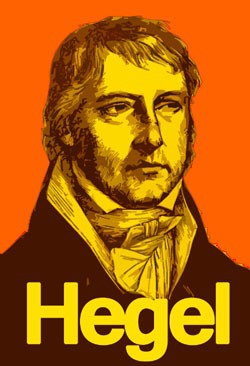samedi, 28 février 2015
A Hole in Being: Notes on Negativity
A Hole in Being:
Notes on Negativity
By Greg Johnson
Ex: http://www.counter-currents.com
 G. W. F. Hegel and his able interpreter Alexandre Kojève claim that the essence of consciousness is “negativity,” that man lives “outside himself,” that man “negates” or “nihilates” nature, that man is a “nothingness” or a “hole in being,” that man is “time that negates space.” What does this mean?
G. W. F. Hegel and his able interpreter Alexandre Kojève claim that the essence of consciousness is “negativity,” that man lives “outside himself,” that man “negates” or “nihilates” nature, that man is a “nothingness” or a “hole in being,” that man is “time that negates space.” What does this mean?
First, let’s consider the claim that man contains a negativity or absence within him. Imagine you are holding a rock in your hand. A rock is a paradigmatic natural object. It is an inert lump of matter. A rock is complete and self-contained. To say that the rock is self-contained is to say that it does not need anything from outside of itself in order to go on being a rock. A plant, by contrast, is not self-contained; it needs things outside of itself—water, nutrients, sunlight—in order to go on being a plant. Without these things, it is reduced to a mass of inert matter, like the rock.
To say that the plant is not self-contained and self-sufficient is to say that it has an absence or lack within it; its need is a hole in it that must be filled by something from outside it. The rock, because it has no needs, is wholly self-sufficient and self-contained; it has no absences within it.
Another way of understanding this is to say that what makes the plant whole lies outside of its skin, outside of the space that it inhabits and occupies; what makes the plant whole is literally outside it; the plant is outside of itself, displaced from the physical space that it occupies; another way of putting this is to say that the plant is “ecstatic,” for the word “ecstatic” literally means “out-standing,” being outside of or beside oneself.
The rock, by contrast, is not ecstatic; because it needs nothing from outside itself to make it complete, all that it is lies within the physical space it occupies. To understand a plant as a whole, one cannot simply look at the plant, for what the plant is, is not wholly within its skin; the things that make the plant a whole are found outside it, in the needs which are fulfilled from the environment in which it dwells.
When Hegel/Kojève claim that man contains negativity and absence in him, they mean, first of all, that man has needs and desires, that man is not wholly self-sufficient and self-contained. Human beings lie outside of themselves, outside of their skins, for it is only outside of ourselves that we find those things which fulfill our needs and make us complete.
 Next, let’s consider the ideas of “negating” and “nihilating” nature. When a plant or an animal finds something from the external world that fulfills its needs, it must remove that thing from the outside world and transform and incorporate it into itself. Hegel and Kojève refer to this activity as “negating,” i.e., saying “no.”
Next, let’s consider the ideas of “negating” and “nihilating” nature. When a plant or an animal finds something from the external world that fulfills its needs, it must remove that thing from the outside world and transform and incorporate it into itself. Hegel and Kojève refer to this activity as “negating,” i.e., saying “no.”
A plant transforms sunlight, nutrients, and water into something that they are not; it in effect says “no” to them as they are given and transforms them into something it can use; it says “no” to their objective, external being and makes them part of itself.
When a cow eats the plant, it says “no” to the plant as an objective, external being and incorporates it into itself.
When a human being takes a rock and transforms it into a paperweight or an example, we say “no” to its objective, external being and incorporate it into the network of human meanings and purposes.
Now what does it mean to say that man is “time” that negates “space”? To understand this, we must appreciate an essential difference between human beings and other kinds of beings. All living things, save for human beings, have needs which are given by nature and which are satisfied within the natural world. Animals may say “no” to given nature, but it is only to satisfy their natural needs, so the process of negation is situated within and bounded by the order or economy of nature.
This is not the case with human beings. Human beings have naturally given needs. But we also have needs which are not given by nature and which cannot be satisfied by given nature. Human beings, unlike all other living things, can say “no” to their own naturally given needs—to their animal natures—and to the entire economy of the natural world. Among the strongest human needs are for physical survival and biological propagation. But Human beings say “no” to the real in the name of the unreal or the unrealized, of the ideal or the idealized.
Human beings have the power of language, reason, speech, abstraction, invention, creativity, logos—what Hegel calls the realm of the concept—which allows them to create needs, ideals, and plans which are not based on nature and cannot be satisfied by it. They can be satisfied only by the transformation of the natural world through work. It is here that the dimension of time enters in.
Hegel claims that:
Man = Negativity = Time = Concept
To say that the concept = time is to say that the concept is a plan, a blueprint for a process of transforming what is given in the present into what is desired in the future. To say that man = time is to say that man’s unique mode of being, man’s unique mode of negativity, is the transformation of the natural world through our projects. Man, therefore, is time that negates.
But what does it mean to say that man is time that negates space? By space, Hegel/Kojève mean nature, given being, inert reality, which is to be changed in light of our concepts and plans. Hegel/Kojève use “space” to designate given being, because given beings, unlike living beings, are wholly self-contained and self-sufficient; because they need nothing outside of themselves to be complete, all that they are is found within their given spatial location.
To say that man is time that negates space, is, therefore, to say that man is time that negates given being in the light of his concepts and plans. We say “no” to what is given now in the name of the not yet, what is conceived in the mind and realized through the transformation of given nature.
There is a phrase from Jean-Paul Sartre that is often quoted by people who want to argue that French philosophy is all a bunch of gobbledygook:
Man is what he is not and is not what he is.
On the surface this does sound like nonsense, but it actually makes a great deal of Kojèvian sense.
To say that man is what he is not, is to say that human beings are not just lumps of inert given being; human beings have physical-material-animal bodies, but the body is simply the site at which a potential of infinity of plans and projects burst out in all directions, toward myriad possible futures.
Human beings are what they are not because they live in their plans and projects, encountering their given reality as incomplete in light of all the things they want to achieve.
Human beings are not what they are—i.e., the given matter within our skins—because what we are is radically incomplete, and can be completed only by completing our plans and projects, and since we always have uncompleted plans and projects, which are cut off only by death, man is always incomplete, a hole in being that will never be fully filled.
Article printed from Counter-Currents Publishing: http://www.counter-currents.com
URL to article: http://www.counter-currents.com/2015/02/a-hole-in-being/
URLs in this post:
[1] Image: http://www.counter-currents.com/wp-content/uploads/2015/02/book-transforming-itself-into-a-nude-woman-1.jpg
00:05 Publié dans Philosophie | Lien permanent | Commentaires (0) | Tags : philosophie, hegel, kojève, négativité, hegelianisme, philosophie politique |  |
|  del.icio.us |
del.icio.us |  |
|  Digg |
Digg | ![]() Facebook
Facebook


